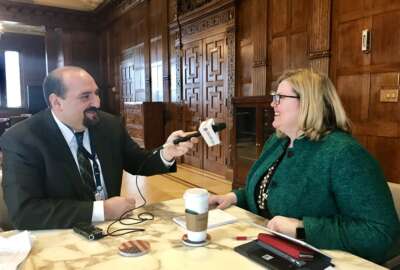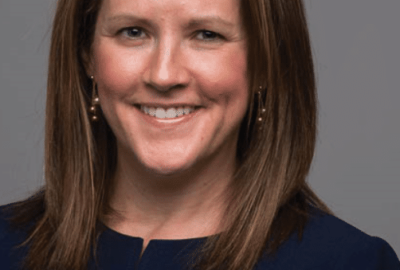
For transparency at GSA, squeaky wheel finally gets a little oil
GSA Administrator Emily Murphy said starting for next fiscal year it will run a pilot where the agency would publish its statements of work after award using e-...
Best listening experience is on Chrome, Firefox or Safari. Subscribe to Federal Drive’s daily audio interviews on Apple Podcasts or PodcastOne.
It’s a bit too early to pop the champagne and begin celebrating. But when Emily Murphy, the administrator of the General Services Administration, announced a new pilot this fall that would begin to shed some light on the schedules program, my heart skipped a beat.
For the better part of a decade, I have been asking — sometimes nicely, other times less so — for GSA to make requests for proposals, requests for information and contract awards under the schedules program visible for non-schedule holders.
So there I was at the Coalition for Government Procurement’s (CGP) spring conference in Falls Church, Virginia, on May 16 when Murphy dropped the news.
“If we are trying to attract vendors and customers to our schedules being clear about what is actually bought is really helpful,” Murphy said at the event. “One of the areas GSA is looking at starting for next fiscal year is a pilot in the agency so after award using e-Buy, GSA would publish its own statements of work. We would publish the results of this so we would be clear what it is we are buying from the schedules. I asked for defined metrics for how we will decide whether that’s a successful buy. It’s an area I’m excited about because it goes back to those principles of transparency and increasing competition.”
Now it’s just a pilot, and it doesn’t start for several months. But the fact that Murphy and others such as Alan Thomas, the Federal Acquisition Commissioner; Mary Davie, the FAS deputy commissioner; and many others recognized this as a shortcoming and are willing to try something is a major step forward.
4 priorities for newest GSA admin
The news about the planned pilot was one of several specific examples of her plans Murphy brought to CGP’s annual event. For reasons of full disclosure, CGP has a show called Off the Shelf on Federal News Radio.
Murphy started by driving home her four overarching priorities with each speech and each interview over the last five months. She then put some details behind those four priorities of increasing competition, ethical leadership, increasing transparency and reducing duplication.
From all signs, if GSA can accomplish many of these initiatives, Murphy’s tenure will live up to expectations.
The biggest lift may be in modernizing the federal payroll providers. GSA issued a pre-solicitation notice on May 17 for a 10-to-13-year contract worth upwards of $2.5 billion.
GSA wrote on the notice that it plans to “compete its requirement to modernize the Payroll and Work Schedule and Leave Management (WSLM) ecosystem. The competition will be conducted among holders of GSA IT Schedule 70 contracts, SINs 132-40 and 132-51. The government expects to award one or more Blanket Purchase Agreements (BPAs) under which orders may be placed directly by participating federal agencies.”
GSA expects to issue the final request for quotes in June.
“Under the President’s Management Agenda, GSA is charged to be the co-lead with the Office of Management and Budget to provide quality services,” Murphy said. “I think it’s always important to remember that the goal is to provide quality shared services, not just shared services.”
She added that the government spends $28.6 billion a year on administrative services, and speculated that if surveyed, federal executives would say they were unhappy with the quality of those services.
“If you are going to spend nearly $30 billion, you want to be happy with the results,” she said. “For GSA, the challenge is not can we put together another contract vehicle. It’s how can [we] go out and help agencies. To be very clear this is not something GSA is doing to another agency or is doing for another agency — this is something GSA is doing with other agencies.”
She said the shared services effort is about agreeing on what is needed and then coming up with the best solutions for everyone. That could mean a common set of contracts or designating agencies to provide the services or a single provider supplying a service to all others, such as the Treasury Department processing payments.
“One area that OMB and GSA have been working with agencies right now is putting together a checklist on how ready are you to transition to a new payroll system,” Murphy said. “Instead of saying, ‘We have [a] new contract, everyone move,’ it’s a quarter-by-quarter, month-by-month set of items to make sure we are ready to transition. This isn’t an overnight solution. This is a 10-year process GSA has sketched out with OMB. The end goal is savings and a better service.”
New shared services strategy explored
Maybe the biggest differences in this shared services effort are the use of software-as-a-service and the broad recognition that providers need to make a “profit” to ensure they can continually upgrade their services.
To that end, Murphy said many of these shared services will be contracts for commercial services with at least three solutions.
“One area I’ve asked everyone to look at also is whether we could use a model somewhat similar to the EIS model for networks, where we retain a portion of the fees to pay for the next round of transition so we are not finding ourselves in a few years locked into one solution without the ability to pay for the transition to the next. Let’s start starting planning for transition now,” she said. “In other cases, it could be that GSA instead of helping to support contracts is actually for the SaaS or commercial services is instead helping agencies better align the personnel and providing them with support to manage the systems they already have as they prepare for transition.”
Another opportunity GSA is exploring for shared services is around document digitization to meet the National Archives and Records Administration’s requirements.
“OMB came to us asking about NARA’s requirements for digitization, and we were able to say we have two new special item numbers (SINs) under the schedules program that could help agencies with that,” Murphy said. “ Now we are working with them on how to leverage the schedules to adopt digitalization and records management solutions.”
Read more of Reporter’s Notebook
Copyright © 2024 Federal News Network. All rights reserved. This website is not intended for users located within the European Economic Area.
Jason Miller is executive editor of Federal News Network and directs news coverage on the people, policy and programs of the federal government.
Follow @jmillerWFED
Related Stories
 Exclusive
Exclusive 




